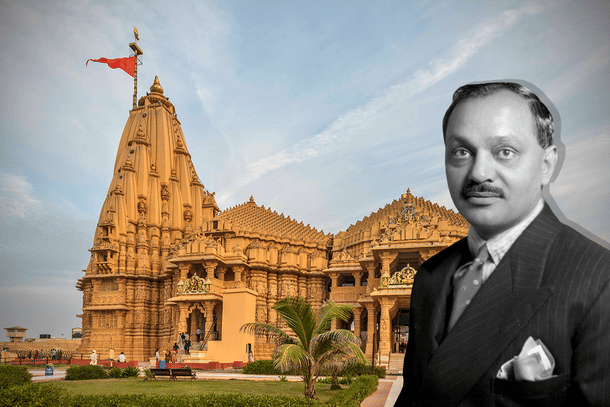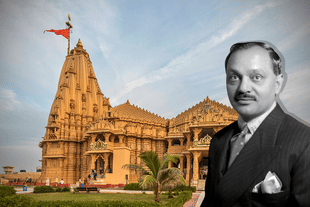Culture
Water From Rivers, Streams, And Oceans Of 115 Countries Across Seven Continents: Before Ayodhya, There Was Somnath
Aravindan Neelakandan
Sep 21, 2021, 06:22 PM | Updated 06:21 PM IST
Save & read from anywhere!
Bookmark stories for easy access on any device or the Swarajya app.


According to a Press Trust of India (PTI) report, Defence Minister Rajnath Singh said on 18 September 2021 that water from rivers, streams and oceans of 115 countries across seven continents would be obtained to offer in the construction of the Ram temple in Ayodhya. He further stated that this 'innovative thinking' was to replicate the message of Vasudhaiva Kutumbakam — all world is one family.
However, it may not be a new idea per se.
Soon after Independence, when Somnath Temple was getting reconstructed, the same idea was thought of by Maharaja Jam Sahib of Nawanagar, Digvijaysinhji Ranjitsinhji — a Hindutvaite who had saved human lives during the darkest period for the West in the twentieth century.
Read on:
On 23 August 1939, the infamous Molotov-Ribbentrop Pact was signed between the regimes of world's two cruellest mass murderer-dictators Joseph Stalin and Adolf Hitler. Both the Soviet Union and Nazi Germany invaded Poland silently.
Soon, about 1,000 Polish children, mostly Jews and Catholic, found themselves in Siberia. General Władysław Sikorski — the first prime minister of the Polish Government in Exile and Commander in Chief of the Polish armed forces — appealed to Winston Churchill to protect these children.
In 1942, the Soviet Union no longer wanted to hold these children and deported them out of Siberia. With no land to go to, these child refugees from Soviet Gulags arrived at Bombay port, only to be denied entry by the British.
The maharaja, who was then a member of the Viceroy's War Council, came to know of the plight of these children and used his power and influence to get them into his own territory and created comfortable living and learning quarters for them at Balachadi, about 25 km from his capital Jamnagar. Later by 1946, the children were taken to another accommodation with facilities in Kolhapur.
While in recent days a lot has been written about this king and his humanitarian efforts to save the children not much has been stated about his core Hindutva worldview.
The maharaja was also a staunch Hindutvaite. As the Chancellor of the Chamber of Indian Princes, he warned of the dangers that Hinduism was facing and exhorted the Hindu princes to be defenders of Dharma.
At a reception given to him at Delhi by Hindu Mahasabha, he said:
Whatever may have been their history, the Rajputs have always put their religion first. We are Hindus and whenever Hinduism is threatened neither I nor my brother Princes can remain behind to defend it to the last. ... Today Hinduism, like the Indian States is attacked from within and without but the princes will make sacrifices and stem the tide.
In independent India, ‘Jam Sahib’ also became the Rajpramukh of Saurashtra government and also the chairman of the Somnath temple trust. The trust was for rebuilding the demolished Somnath Temple and consecrate it.
Yale-based religious studies scholar, Richard H Davis, narrates what ‘Jam Sahib’ did for the Somnath Shiva linga consecration:
As board chairman, the Jam Sahib took on the royal role of Yajamana in the rituals of establishment necessary for construction of the new temple. He wrote letters to Indian diplomats serving as ambassadors of the new nation state around the world, asking that each send him soil, water and twigs from the countries in which they were stations to be used in the installation ceremony of the new Siva Linga. … In this way Jam Sahib hoped the installation might symbolize, 'the unity of the world and the brotherhood of man.'
Dr Davis further explains the religious significance and upgrading of the significance to imply a universal symbolism:
Jam Sahib's intention to make this major installation ceremony as encompassing as possible was nothing new in Hindu ritual practice.... What was new was the post-World War II world order, with its worldwide networks of diplomatic missions, which enabled Jam Sahib to envision a consecration ceremony more comprehensive and international than ever before it. Siva Somanatha could become the most universal of all India's icons.Richard H. Davis, Lives of Indian Images, Motilal Banarsidass, 1997:2015, pp.216-7
However, certain diplomats, particularly K M Pannikar, ever anxious to please Nehru, were not amused. They complained to Nehru. And Nehru in turn wrote letters to K M Munshi criticising such a move.
When in 1968, Mira Alfasa, the spiritual collaborator of Maharishi Sri Aurobindo, better known as ‘the Mother’ — herself of Jewish descent and a strong opponent of Nazi darkness — inaugurated Auroville, the futuristic city of her and Sri Aurobindo's vision, by symbolically placing an urn containing soil from 124 nations, she partially fulfilled the global Hindu vision of the erstwhile Raja of Jam Nagar.
Yes. Those who want to de-Hinduise the Auroville forget that its universal vision is rooted in Hindu worldview and values.
What ‘Jam Sahib’ envisioned for Somnath Shiva linga in 1951 has now materialised in its own way.
From Somnath's reconstruction to rebuilding of the temple in Ayodhya, Hindu rejuvenation has always brought out the vision of all humanity with all its diversity as one family.
This then is the vision of global Hindutva — not that of proselytising, conquest and supremacism but that of peace and benediction, validating all diversity and asserting our common humanity.





